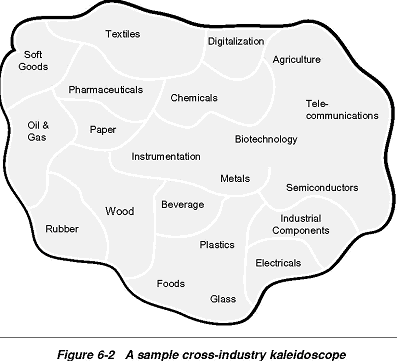Automotive
Understanding Opportunities across Industries
Think for a moment about the number of supply chain constituents whose actions can impact Ford, GM, or Daimler-Chrysler. Major manufacturers of automobiles rely on power companies for their assembly lines, on tire companies, on petroleum by-product and chemicals companies for carpeting, on tanners and plastics manufacturers for upholstery and trim, and on glassmakers for glass and mirrors. They depend heavily on steel production; on tool-and-die parts manufacturers; on builders of pumps, radiators, flywheels, and gears; on specialty engine manufacturers and suppliers; on makers of wire, hoses, and belts; and on electrical experts for resistors, capacitors, solenoids, plugs, connections, and distributors. Increasingly, they even rely on makers of silicon chips not only because todayís cars require computer controls, but because the heavy equipment these companies design and build to help automate their assembly lines is also reliant on computer-controlled programming and functionality. The example of an automaker is useful for a further reason.
From one perspective, automobile manufacturers represent the ways supplier and customer relationships are intertwined across industries in multiple sectors. But itís even more useful to consider that the automobile industry is a convergence of industries and that all the relationships between different manufacturers and suppliers are continually in flux. This means not only that opportunities can arise at intersections in the web of relationships, but also that other opportunities can arise even where intersections donít yet exist.
In Figure 6-2, a cross section of industries is represented as existing in a kaleidoscopic relationship: they all intersect with one another; they all interact with one another, they all illuminate one another. White spaces are the possible intersections between industries and those white spaces mean opportunities.
The best way to understand these opportunities is to look at the ways different industry sectors can converge and a new product emerge hopefully creating its own market. In the 1970s, the Wrigley Company spent millions to promote sugar-free gum to sell its product to people who were fearful of tooth decay. But, in 1999, when SmithKline Beecham introduced its new dental gum under the Aquafresh name, it promoted a new chewing gum which is traditionally a type of flavored candy as an aid to both dental care and oral hygiene. The company suggested that consumers use their Aquafresh dental gum as an adjunct to brushing their teeth. In this way, SmithKline Beecham crossed the perceived boundaries among a candy manufacturer, a provider of dental hygiene, and a supplier of oral hygiene products, blending desirable attributes of all three in a new product and thereby creating a new market.
Nor is this the only example of cross-industry opportunities. Consider the technology of liquid plasma displays one of the fastest growing technologies in the world. It is a combination of two very different fields electrical engineering and synthetic fibers or textile technology. In the healthcare sector, Bausch & Lomb is attempting to create a canopy of total healthcare by converging three distinct industries: vision care (contact lenses and glasses), surgicals (medical instruments, disposables, and so on), and pharmaceuticals.
The questions for companies to ask are:
- What competencies, processes, and technologies do we have that are transferable across the intersections between industries?
- Where can we create new solutions and solve new problems?
- Where are the new growth areas?
- How can we provide full solutions that combine the attributes of different industries?
Creating a Full Solution
Cars combine microchips and metals, software and soft leather, manufacturing and marketing, repair and consumer finance. In constructing the full supply chain, car companies must bring together a very wide range of competencies, seeking mutually complementary abilities in supply chain partners from a range of industries. At the same time that supply chain partners should share similar business principles, they should also have some dissimilar aspects, bringing complementary, interlocking pieces of a solution together.
For example, you might choose to emphasize innovative product design and marketing, while your various supply chain partners emphasize customer credit, efficient manufacturing, and order fulfillment. Optimal dissimilarity in a supply chain is especially apparent in convergent industries such as the automotive industry. Although the business models for car manufacturing, car sales, car financing, and car repair are all very different, they must mesh at certain crucial interfaces. Cars must flow from manufacturers (with a production-based business model) to dealers (with a consumer-retail business model). Likewise, car sales are linked to financing (whose business model emphasizes managing its risks and collecting monthly payments) because a particular customer wants both the car and financing or lease qualification. These flows and links represent connection points in a supply chain. Explicitly choosing these connection points is where your supply chain strategy meets your business model. Important elements of your business model will need to match corresponding elements in your supply chain partnerís business model. If there is a gap between where your companyís processes leave off and where your partnerís processes start, there will be problems in the supply chain and opportunities for you, a partner, or a competitor to add value by filling in the gap. It is important to recognize that in a vastly changed economy, driven by information technology and the Internet, traditional relationships between certain types of companies also change. Today, we see a new role played by companies that act as aggregators and disseminators of information: infomediaries. These companies exist in cyberspace as well as on terra firma.
